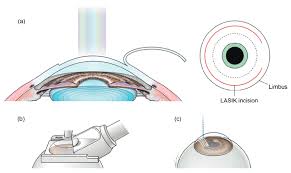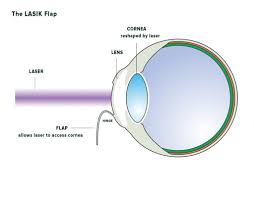Table of Contents
ToggleThe reliable Smile Pro method has helped thousands of patients see more clearly. Effective medical professionals have successfully performed over 30 lakh Smile Pro procedures globally. SMILE: It corrects 1.0 D of prescription power by using 35–45 microns of optical tissue. So, Is Smile Pro Surgery Bladeless? Let’s check!
Management is the main advantage of the bladeless function. When compared to blade treatments, without blades, laser eye surgery dramatically lowers the chance of flap issues such as holes for buttons (caused by aberrant lamellar cuts), incomplete flaps, or loose wraps (at which the outer layer of the corneal flap’s connector separates).
The most recent iteration of the SMILE procedure for laser eye surgery is called SMILE PRO (Small Incision Lenticule Extraction). Laser cataract surgery, also referred to as “keyhole” surgery, is mild, simple, and painless. The healing period is shorter than other treatments, with a lower risk of spreading infection and a sore eye.
What steps comprise the SMILE process?
First step: making the lenticule
A tiny cut and lenticule of corneal tissue are made within the intact cornea.
Eliminating the lenticule in step two:
The lenticule has been eliminated with little damage to the cornea using the little incision.
Step 3: Refractive error correction
The cornea’s shape is altered by eliminating the lenticule, rectifying the refractive defect.
What are the benefits of SMILE PRO?
LASIK requires a significantly wider cut to form a complete flap, but SMILE requires a minor incision (80% smaller than LASIK).
LASIK is a two-step laser process, while SMILE is a one-step laser operation. As a result, SMILE treatment can be finished in under 30 seconds.
Compared to LASIK, SMILE causes less damage to the higher cornea layers, reducing the risk of dry eye or infections following surgery. With SMILE, people heal more quickly and can frequently see properly in days. In contrast to LASIK, which may have a little burned odor and an audible laser, SMILE is quiet and odor-free.
For whom is SMILE PRO laser eye surgery appropriate?
Several individuals are suitable candidates for SMILE PRO surgery:
Over 21 years old with a steady refractive (prescription) for over a year.
People who are myopia (short-sighted) or astigmatic
Those who wear spectacles or contacts and have excellent vision
For whom is SMILE PRO Laser Eye Surgery not appropriate?
Farsighted (hyperopic) individuals are not now eligible for SMILE. However, that could alter in future years.
Patients cannot be lactating or expecting.
Patients older than 45 with long-sightedness may benefit more from a Refractive Lens Exchange.
What to anticipate after your SMILE PRO procedure?
Throughout the process
Each eye takes roughly five to ten minutes to complete the entire SMILE process (setup and operation). The outside of the eyelid will be numbed using local (eye drop) anesthesia so there won’t be any discomfort.
Additionally, a device will be implanted beneath the eyelids to prevent you from closing your eye or blinking throughout the process.
During the operation
The physician will speak to you and explain what to look for. Although there may be some pulling as the physician extracts the lenticule, there will be no discomfort.
The surgeon will use antibacterial and steroid eye drops after the procedure. After that, people will be transported to a room for consultation, where the doctor will go over the procedure and examine the cornea. It’s common for vision to seem fuzzy. After an operation, it’s crucial not to irritate the cornea.
Before surgery
Please plan on spending a few hours at the place. This involves advising you what to anticipate in the laser treatment suite before the procedure and giving you a few drops containing a sedative.
It is crucial to bring someone from your family or close friend who can drive you home following the treatment. Although you can see, driving is not permitted, and your vision will be more receptive to lights. Wear cozy, warm clothing because the laser area is designed at a specific degree and moisture content to guarantee the laser’s appropriate operating temperatures.
Contact lens lenses should be used only after operation if you use them. You will receive another explanation of this during your free evaluation.
Healing from surgery
You will be provided thick eye shields that you put on while you rest to stop you from scratching your eyes.
You will receive a dose of antibiotics and steroid drops to use regularly.
A check-up will be done the next day, and another will be done a week later. To check on the healing process and test your vision, you must return after three and six months, respectively.
So, Is Smile Pro Surgery Bladeless??
One of the most common questions people have about the SMILE procedure is whether or not it is bladeless.
The answer is yes; SMILE is a bladeless procedure. Instead of using a traditional microkeratome blade to create a flap in the cornea, the SMILE procedure uses a femtosecond laser to create a small incision.
It is minimally invasive and is very accurate. If you are considering laser eye surgery, the SMILE procedure may be worth exploring.
Will SMILE manage upcoming eye disorders?
Any surgical procedure on the eyes precludes the treatment of subsequent eye diseases. This also applies to SMILE. What does this indicate? Yes, SMILE can correct astigmatism and nearsightedness. However, it does not stop you from getting presbyopia or cataracts. Especially current reflection problems are fixed using SMILE. However, the reality that the operation is irreversible remains unchanged. You will not need spectacles or lens implants even if you get these problems. The restoration that SMILE creates is permanent and unrepairable.













